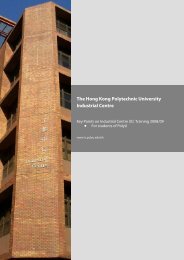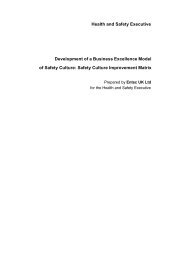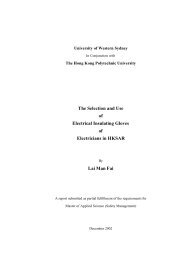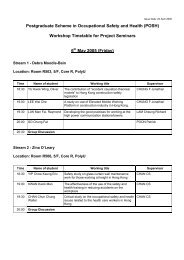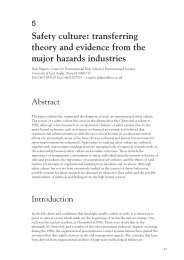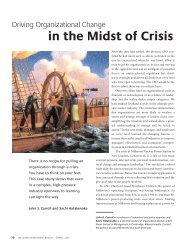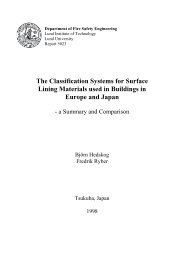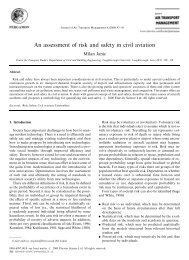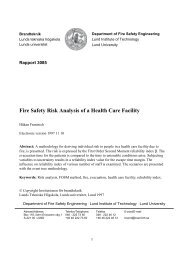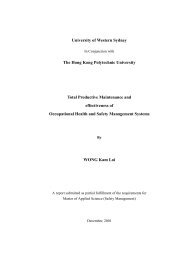Assessing safety culture in offshore environments - Industrial Centre
Assessing safety culture in offshore environments - Industrial Centre
Assessing safety culture in offshore environments - Industrial Centre
You also want an ePaper? Increase the reach of your titles
YUMPU automatically turns print PDFs into web optimized ePapers that Google loves.
112 S.J. Cox, A.J.T. Cheyne / Safety Science 34 (2000) 111±129In the wake of such changes, a Cross Industry Safety Leadership Forum has beenestablished to facilitate the shar<strong>in</strong>g of safe work<strong>in</strong>g practices. The members of thisforum recently highlighted a number of <strong>in</strong>dicators of improved <strong>safety</strong> performance(Cross Industry Safety Leadership Forum, 1997), <strong>in</strong>clud<strong>in</strong>g an overall decrease <strong>in</strong>reported <strong>in</strong>jury frequency rates and an estimated $5 billion <strong>in</strong> <strong>in</strong>vestments <strong>in</strong> healthand <strong>safety</strong>-related improvements. However, despite these overall e€orts, there issome evidence to suggest that the rate of improvement, as measured by accident/<strong>in</strong>jury frequency, has slowed down over the past 2 years (HSE, 1997; Cox andCheyne, 1999). Furthermore the Cross Industry Safety Leadership Forum (1997)have also con®rmed that much of the exist<strong>in</strong>g e€orts <strong>in</strong> support of these improvementshave been focused upon technology and management systems rather thanhuman factors. They also suggest that potential for future improvements may bestbe realised through enhanced e€orts <strong>in</strong> the areas of human factors and through theassociated developments <strong>in</strong> health and <strong>safety</strong> <strong>culture</strong>. In light of this <strong>in</strong>itiative thispaper considers how o€shore <strong>in</strong>stallation managers can gauge their <strong>safety</strong> <strong>culture</strong>.Discussion here focuses on the development of a generic <strong>safety</strong> <strong>culture</strong> assessmentmethodology which was designed to support improvements <strong>in</strong> <strong>safety</strong> performanceacross the sector.This paper describes a series of studies that are focused on the practical needs ofo€shore managers and workers for the monitor<strong>in</strong>g of <strong>safety</strong> <strong>culture</strong> through thedevelopment of a self-assessment tool. It aims to give a broad overview of thedevelopment of this methodology (Cox and Cheyne, 1999) and draws heavily uponrecent work carried out <strong>in</strong> the UK sector of the North Sea. It also explores thepractical utility of the concept <strong>in</strong> o€shore <strong>environments</strong>. The methods describedhere are concerned with both the development and pilot<strong>in</strong>g of this tool. Whereas themethodology is based on sound <strong>safety</strong> science, the overall aim of the assessmentprocess is to chart a path through, what is <strong>in</strong>creas<strong>in</strong>gly becom<strong>in</strong>g, a conceptualm<strong>in</strong>e®eld (Cox and Fl<strong>in</strong>, 1998), and one <strong>in</strong> which researchers have been challengedby <strong>in</strong>dustry to address practical issues (Cox and Lacey, 1998). Although much hasbeen done <strong>in</strong> other sectors (e.g. Hale and Hovden, 1998; Hofmann and Stetzer,1998) <strong>in</strong> these studies the cultural context for <strong>in</strong>vestigation is set with<strong>in</strong> the o€shore<strong>in</strong>dustry.1.1. Previous studiesA number of previous studies <strong>in</strong> o€shore <strong>environments</strong> have, either directly or<strong>in</strong>directly, considered employee perceptions and elements of health and <strong>safety</strong> <strong>culture</strong>.In an early study, Marek et al. (1985) exam<strong>in</strong>ed risk perceptions, stress andaccidents among di€erent work groups on an o€shore <strong>in</strong>stallation. They identi®edthe ma<strong>in</strong> <strong>in</strong>¯uences on <strong>safety</strong> as the implementation of a <strong>safety</strong> policy, `correct'<strong>safety</strong> management and <strong>safety</strong> promot<strong>in</strong>g activities, and <strong>in</strong>corporation of employees'views <strong>in</strong> design<strong>in</strong>g <strong>safety</strong> programmes. Similarly Rundmo (1993) implemented aquestionnaire survey of personnel on eight o€shore <strong>in</strong>stallations <strong>in</strong> the Norwegiansector of the North Sea; ®rstly to determ<strong>in</strong>e the personnel evaluations of riskresources and, secondly, to identify di€erences <strong>in</strong> risk perceptions among di€erent



